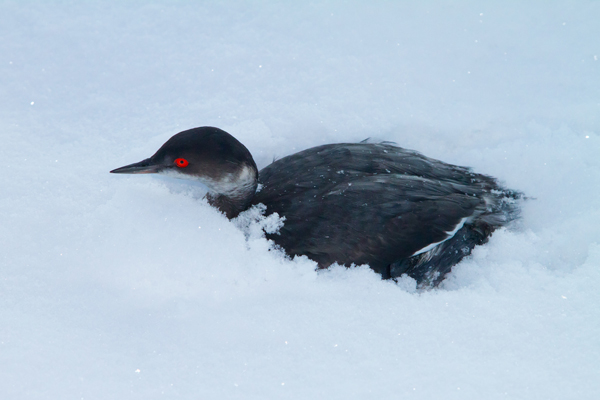Thousands of Birds Dive-Bomb Utah Parking Lots

Thousands of migrating birds crash-landed onto parking lots and other thinly snow-covered surfaces in St. George, Utah, Monday night (Dec. 12), apparently mistaking the glinting open spaces for lakes. Community members and state wildlife officials are working together to clean up from the disaster, rescuing survivors and disposing of the casualties.
"Thousands came down. They came down everywhere. We were able to rescue about 2,000, but most of them, of course, didn't survive the impact," Lynn Chamberlain, conservation outreach manager at the Utah Division of Wildlife, told Life's Little Mysteries, a sister site to LiveScience.
The birds were eared grebes, common waterbirds that migrate from Canada and the northern and western United States in summer to the Southwest and Mexico in winter. According to Chamberlain, the birds are fantastic swimmers and divers, but their legs are so far back on their bodies that they are unable to walk on land. "They have to land on water; if they land on any kind of ground they can't take off. So we had to gather up [the survivors] and release them in a pond in Washington County, where it doesn't ice over," he said.
Community members have helped tremendously with the rescue work, he said.
So why did the birds decide to land on city pavement?
"People spend years studying flock behavior," Chamberlain said. "It's hard to say why they all come down together; all we know is that they have leaders in the front of the flock, and they respond to what the leader is doing. Likely they were all ready to come down, and it was a perfect storm of situations: There was a storm, the lights coming up from the town were reflected against the clouds, they saw a parking lot that was well-lit and covered in 6 inches of snow, and it looked like a body of water."
Despite this tragic collision between nature and humanity's footprint, Chamberlain said there isn't much cities can do to prevent repeat incidents. "The only thing you could do is figure out when they're migrating over, and cut the power in the city. That's not going to happen."
Sign up for the Live Science daily newsletter now
Get the world’s most fascinating discoveries delivered straight to your inbox.
Fortunately, grebes aren't endangered or even vulnerable, and for the thousands that died in St. George, there are millions more that live on.
This story was provided by Life's Little Mysteries, a sister site to LiveScience. Follow Natalie Wolchover on Twitter @nattyover. Follow Life's Little Mysteries on Twitter @llmysteries, then join us on Facebook.
Natalie Wolchover was a staff writer for Live Science from 2010 to 2012 and is currently a senior physics writer and editor for Quanta Magazine. She holds a bachelor's degree in physics from Tufts University and has studied physics at the University of California, Berkeley. Along with the staff of Quanta, Wolchover won the 2022 Pulitzer Prize for explanatory writing for her work on the building of the James Webb Space Telescope. Her work has also appeared in the The Best American Science and Nature Writing and The Best Writing on Mathematics, Nature, The New Yorker and Popular Science. She was the 2016 winner of the Evert Clark/Seth Payne Award, an annual prize for young science journalists, as well as the winner of the 2017 Science Communication Award for the American Institute of Physics.










